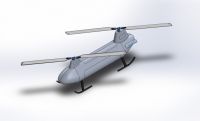Success in First Round of 2018 UAS Flight and Payload Challenge
A design concept paper submitted by a team (called EndureAir) of students from MAV and VTOL lab of Aerospace Engineering department and guided by Professor Abhishek recently won the first stage of "the Unmanned Aerial Systems Flight and Payload Challenge" organized by National Institute of Standards and Technology (US Department of Commerce) and Public Safety Communications Innovation Accelerator (USA). The team comprised of members of MAV and VTOL lab: Mr Ankur Duhoon (Research Engineer), Mr Sagar Setu (PhD), Mr Nidhish Raj (PhD) and Mr Karthik. S. (M.Tech). Approximately 50 teams across the globe participated in this challenge, of which ten teams have been selected to go to next stage. The team would be also guided by Prof. Jayant Sirohi from University of Texas at Austin.
The challenge was inspired by the shortcoming of current Unmanned Aerial Systems (UAS) used in the public safety realm, which is payload versus flight time. Vertical takeoff and landing (VTOL) UAS provide many different mission capabilities, but their flight time is limited. The payload capacity, energy source and flight time are linked through design trade-offs that can be optimized for efficiency and flexibility. This challenge requires to keep the UAS and its payload airborne for the longest time possible to support first responders’ communication technology on the ground while they conduct their search. The advancement of UAS research will help search and rescue operations support payloads for wireless communications or other life-saving goods to save lives.
The award money of US $20,000/- for the first round will be used to design, fabricate and demonstrate the proposed design from the concept paper which consists of a tandem rotor helicopter design with approximate all up weight of 25 kg with ability to lift 10 kg payload and fly for at least 1 hour with the constraint of the entire vehicle fitting in a box of 6 ft. x 4ft. x3 ft. dimension. The final leg of the competition involving flight test demonstration would happen in May 2018 in USA.
Link with the accouncement: NIST
